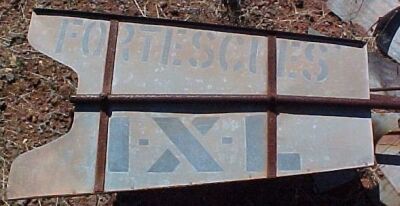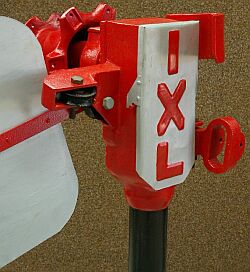


LEFT The style of tail vane fitted to Western Australian models sold by "Elders Smith & Co, Ltd" from at least 1922 to 1932. Elsewhere in Australia a much less decorative corrugated sheet was used for the tail vane. Evidence from a mill collected in the Marble Bar district suggests that the corrugated sheet was also used for the tail vane of the earlier model "IXL" also on display at the Morawa Museum.
There are several differences to the earlier model IXL's, as can be seen by examining the hub, and in particular the main casting. This component is now in two parts with a separate casting for the nose, which bolts to the main body of the head and allows for easier fitting of the hub shaft. The change appears to have occurred sometime after 1919, when the hub had already been revised, and during or before 1925.
As with the earlier model, this version is also supplied with serial numbers. These are stamped into a brass plate riveted onto the side of the engine box. The highest serial number sighted so far is 3298 but as this mill was probably erected in the mid to late 1920's the serial numbers should go much higher.

By then there had been a few more changes in the design, especially in the furling system. The top tail hanger bracket, which had been bolted to the top of the main casting, was done away with and a replacement of quite different design was now bolted to the right side of the casting, as seen from the rear. This not only acted as an attachment point for the tail hanger, but the short chain now fitted on the top end of the tail hanger bent around the curved plate to keep the hanger away from the main casting's pressed tin back cover. The tail spar buffer, which had been mounted at the end of the furl arm, was shifted to be alongside the main body of the mill and was now a large flattened ring shape.
Geo. E. Fortescue & Sons also incorporated shock absorbing compression springs in the furling system, to cushion the tail spar from damage as it snapped back into position during sudden lulls in high winds. Similar compression springs were used in the pump rod system to take the knock out of the mill as it went over or took up the stroke.
In Western Australia the Fortescue IXL windmill was sold by Elder, Smith & Co, Ltd until at least 1932, which is also the date of the latest advertisement recorded for the "IXL" windmill.
This windmill was donated to the Morawa Museum by Lynne and Joe NORTH of Gutha.